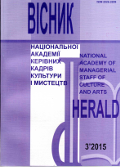ДО ІСТОРІЇ МИСТЕЦТВА ВІТРАЖУ У КОНТЕКСТІ ДУХОВНОЇ ЖИТТЄДІЯЛЬНОСТІ ЛЮДИНИ
To the history of the stained-glass windows art in the context of the man spiritual activities
Author(s): Svitlana Obors’kaSubject(s): Architecture, Visual Arts, Ethics / Practical Philosophy, Cultural Anthropology / Ethnology, Sociology of Culture, Sociology of Art, Sociology of Religion
Published by: Національна академія керівних кадрів культури і мистецтв
Keywords: culture; art; religious art; stained glass; window; interior; light;
Summary/Abstract: The article discusses the origins of the art of the stained glass windows, their role in the development of the man spiritual activities. Сreating a mystical and solemn mood the glass painting provides the humanitarian influence on a person, forming his taste and imagination, creative abilities, optimistic view on his own existence. The features of the Christian tradition of the painting on the glass are lighted.As a kind of the monumental and decorative art from the colour stained glass was started by the ancient civilizations. Pantheon of the ancient Egyptian gods and pharaohs livelihoods, fixed with the hieroglyphs and ornaments, became the theme of the polychromatic images on a transparent glass with the colour spectrum from brown, beige and sand to coral and orange-red. The Pompeii excavations have certified that in the Ist century BC the Roman carried the ebb of the the little transparent manufacturing glass which is inserted into the bronze frame, although it is not performed the artistic and decorative function. The Christianization of the Europe facilitated the rapid introduction of the stained glass as a component of the religious art. In particular, the established by church-going Roman architectural structure – the basil – is delineated with slot window, draped stained glass – the colored drawings on the glass. The clean colors also attracted the medieval artists in the manufacture of the coloring miniatures and sculptures. The bright saturation of the stained colors – red, blue, purple and yellow – promoted the objectification of the idea of the sacred unity of the color and the light. And light was a symbol of the God's blessings, goodness, truth, life and of the God as the highest perfection, the polychromatic canonization as the certain ideological value. Gold is widely used for the background in the icons as a fully fledged paint, and also for the image of the reflections of the light. The Byzantines enriched the art of the Roman glass mosaic with the flickering effect, which was achieved by using of the finest gold foil lining. Mosaic cubes arranged at an angle to the surface, which allows each of the glass plane to catch and beautifully reflect the sunlight. According to the contemporaries the art of the Byzantium was presented with the examples of the stained glass, painted with colored enamels. The last still partially are preserved in the Hagia Sophia in Constantinople, as the visitors’ memories of the then capital of the Byzantine Empire say. Unlike the ancient stained glass, the Byzantine style is not so much glass mosaic as the painting on the glass, colored or colorless. With the power of the latter, the artist achieves the effect of the lightness and the lack of the background, when the different elements of the stained glass window are raised above the plane passing to the believers the flimsiness and joy of the soul, because of which they come to the temple. The Byzantine stained glass technique is a kind of the union of the painting on the glass and of the classic stained-glass window. In this style there are no any frame in the order to avoid the effect of the gravity, there the picture is applied on the glass-carrying with the casual artistic painting with the generous involvement of the window light. The art of the stained glass reached the highest artistic level in the Gothic architecture (the cathedrals in Bourges, Paris, Milan, Krakow and others.). The scenes of stained glass’ art mostly have the substantial fragments of the Holy Scripture, the lives of the Christian saints, literary and moralistic ideas and sometimes scenes from the life of the people, full of the satire and humour. In the Renaissance the stained-glass windows were more landscape paintings of the animals, plants and rivers. In the fine art of the Slavic world the elements of the classic stained glass windows appeared much later and were used in the design of the interiors of the churches and less in the homes of the nobles and merchants. Cultural and historical evolution of the technique of the making stained glass throughout the XIXth century occurred in the appropriate terminology: if during the romanticism the polychrome decorative glass was called "transparant painting", "patterned window" it was called in the period of the development of the European realistic art. And already in the entering to the the modern era it was occurred as the modern term "vitrage" (fr. – the insert of the window panes). Widely applicable, along with many other kinds of the art, the stained glass window beyond their assigned place in the artistic hierarchy and is used in the fine and applied arts, architecture and glass production. Scientific and technological progress and the development of aesthetic thought greatly enriched semantics of the modern stained glass.
Journal: Вісник Національної академії керівних кадрів культури і мистецтв
- Issue Year: 2015
- Issue No: 3
- Page Range: 54-59
- Page Count: 6
- Language: Ukrainian

